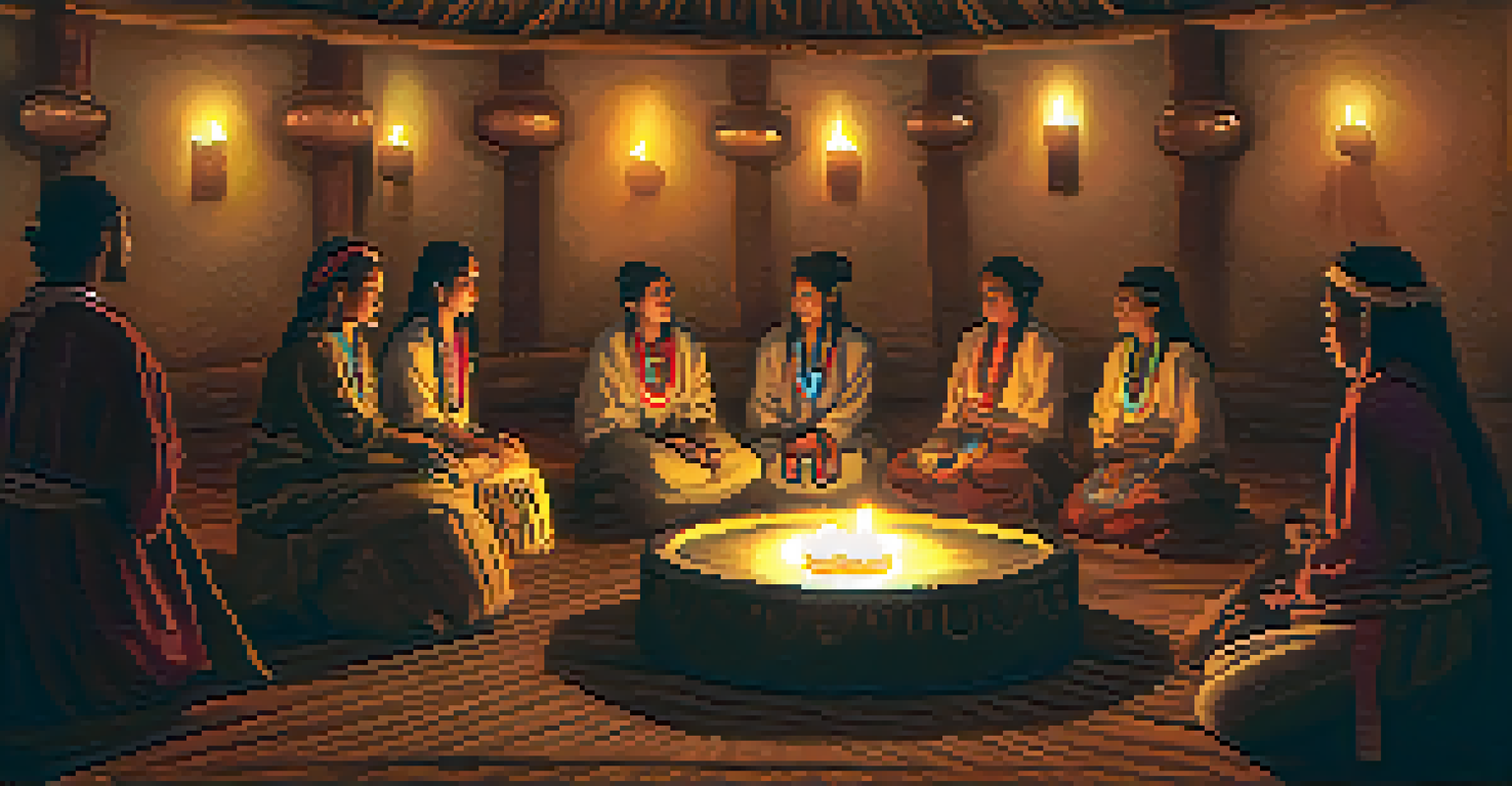Peyote Ceremonies: A Historical Overview of Their Practices

Understanding Peyote: A Sacred Cactus
Peyote, a small cactus native to Mexico and southwestern Texas, has been used for centuries in spiritual ceremonies. This plant contains mescaline, a psychoactive compound that induces altered states of consciousness. For many Indigenous peoples, peyote is not just a plant but a sacred entity that connects them with the divine. The cactus plays a pivotal role in various cultural practices and beliefs.
Psychedelics are a tool for understanding the self and the universe, offering insights that transform lives.
Historically, peyote was used by the Native American Church, a spiritual organization that emerged in the late 19th century. This church blends traditional Indigenous practices with Christian beliefs, emphasizing healing and spiritual enlightenment. The ceremonies often involve singing, drumming, and communal sharing, creating a deep sense of community and connection among participants.
The significance of peyote extends beyond its psychoactive effects; it serves as a medium for introspection and guidance. Participants often report transformative experiences that lead to personal growth and healing. This historical context showcases peyote not just as a substance, but as a vital part of cultural identity and spiritual practice.
The Role of Peyote in Indigenous Cultures
Indigenous cultures across North America have long revered peyote for its spiritual properties. Tribes such as the Huichol and the Lakota have incorporated peyote into their rituals for generations, viewing it as a gift from the Creator. These ceremonies often involve intricate rituals that honor the plant and the spiritual journey it facilitates, emphasizing respect and gratitude.

Ceremonies can vary widely among different tribes, but many share common elements, including prayer, song, and community gathering. Participants often consume peyote in a ceremonial context, which is believed to open pathways to spiritual insights and healing. This communal aspect reinforces social bonds and collective identity, making the experience more profound.
Peyote's Cultural Significance
Peyote is not merely a psychoactive substance but a sacred plant integral to the spiritual practices and cultural identity of Indigenous peoples.
The use of peyote is also steeped in stories and legends that highlight its significance. For instance, many Indigenous peoples believe that consuming peyote allows them to communicate with ancestors or receive visions that guide their lives. These narratives not only enrich the spiritual experience but also connect generations through shared beliefs and practices.
Historical Evolution of Peyote Practices
The use of peyote in spiritual practices has evolved over centuries, influenced by various cultural and historical factors. The late 19th century marked a significant turning point with the establishment of the Native American Church, which formalized peyote ceremonies and provided a legal framework for its use. This evolution reflects a blend of Indigenous traditions and the changing dynamics of American society.
Cultural appropriation is taking something from a culture without understanding its significance, and it can dilute the spiritual essence of sacred practices.
As the church gained prominence, it helped to legitimize peyote use, advocating for the rights of Indigenous peoples to practice their spirituality freely. This movement was crucial during a time when many Indigenous practices were under threat from colonization and assimilation efforts. The church’s influence has allowed peyote to be recognized as a legitimate sacrament, paving the way for its continued use today.
Over time, the perception of peyote has shifted, particularly as interest in psychedelics has grown in modern culture. Today, many people, both Indigenous and non-Indigenous, seek out peyote experiences for personal growth and healing. This shift highlights the resilience of peyote practices while also raising important questions about cultural appropriation and respect for Indigenous traditions.
Peyote and Its Legal Status in the U.S.
The legal status of peyote in the United States is a complex issue, heavily influenced by its cultural significance and the rights of Indigenous peoples. In 1978, the American Indian Religious Freedom Act allowed the use of peyote for religious ceremonies, acknowledging its importance in Native American spirituality. However, this legal protection is limited to members of recognized tribes, which raises questions about access and equity.
Despite these protections, the legal landscape surrounding peyote remains fraught with challenges. Some states have enacted laws that restrict or regulate its use, complicating the ability of Indigenous communities to practice their traditions freely. This ongoing struggle underscores the need for continued advocacy and awareness of the rights of Indigenous peoples regarding their sacred practices.
Legal Challenges for Peyote Use
Despite legal protections for peyote use in religious ceremonies, ongoing challenges persist, particularly for Indigenous communities seeking to practice their traditions.
As interest in psychedelics grows, the conversation around peyote's legal status is evolving. Some advocates argue for broader access to peyote, while others emphasize the importance of preserving its sacredness within Indigenous cultures. Balancing these perspectives is crucial as society navigates the intersection of spirituality, legality, and cultural heritage.
Modern Peyote Ceremonies: Continuity and Change
Modern peyote ceremonies reflect a blend of traditional practices and contemporary influences. Many Indigenous leaders and elders strive to maintain the integrity of their rituals while adapting to the needs of younger generations. This adaptability ensures that peyote ceremonies remain relevant and meaningful in today's world.
In recent years, there has been a resurgence of interest in Indigenous spirituality, with more people seeking authentic peyote experiences. This trend has prompted discussions about the importance of cultural context and the potential risks of commodifying sacred practices. Maintaining the spiritual essence of these ceremonies is essential to honor their historical roots and cultural significance.
Despite the challenges posed by modernity, peyote ceremonies continue to foster connection, healing, and community. Participants often describe these experiences as transformative, providing insight and clarity in their lives. The resilience of peyote practices in the face of change speaks to their deep cultural significance and the enduring power of spirituality.
The Spiritual Significance of Peyote
For many who participate in peyote ceremonies, the spiritual significance is profound and multifaceted. The experience often serves as a pathway to deeper self-understanding, healing, and connection to the universe. Participants report feelings of unity with nature and a heightened sense of awareness, which can lead to significant personal revelations.
In these ceremonies, peyote is often considered a teacher, offering insights that can guide individuals in their daily lives. Many participants seek out these experiences for clarity on life’s challenges, relationships, or personal struggles. This dimension of peyote use underscores the importance of intention, as participants approach the ceremony with openness and respect.
Respecting Indigenous Traditions
As interest in peyote grows among non-Indigenous individuals, it is crucial to engage with these practices respectfully, avoiding cultural appropriation and honoring their historical roots.
The spiritual journey facilitated by peyote can also foster a sense of belonging and community among participants. Shared experiences during the ceremonies create bonds that transcend individual struggles, allowing participants to support one another on their spiritual paths. This communal aspect enriches the overall experience, reinforcing the idea that spirituality is often best nurtured in connection with others.
Cultural Appropriation and Respect for Tradition
As interest in peyote and its spiritual practices grows beyond Indigenous communities, conversations about cultural appropriation become increasingly relevant. Many Indigenous peoples express concern over the commercialization and misrepresentation of their sacred traditions. Respecting the origins and significance of peyote ceremonies is essential to honor those who have practiced them for centuries.
Cultural appropriation occurs when elements of a culture, often marginalized, are adopted without proper understanding or respect. In the case of peyote, this can manifest in non-Indigenous individuals seeking out ceremonies without acknowledging their cultural significance. Such actions can dilute the spiritual essence of the practice and lead to exploitation.

Engaging with peyote ceremonies requires a deep respect for the culture and traditions that birthed them. Non-Indigenous individuals interested in these experiences should seek to learn from Indigenous voices, understanding the historical context and significance of peyote. Building respectful relationships with Indigenous communities is crucial for ensuring that these sacred practices are honored and preserved.